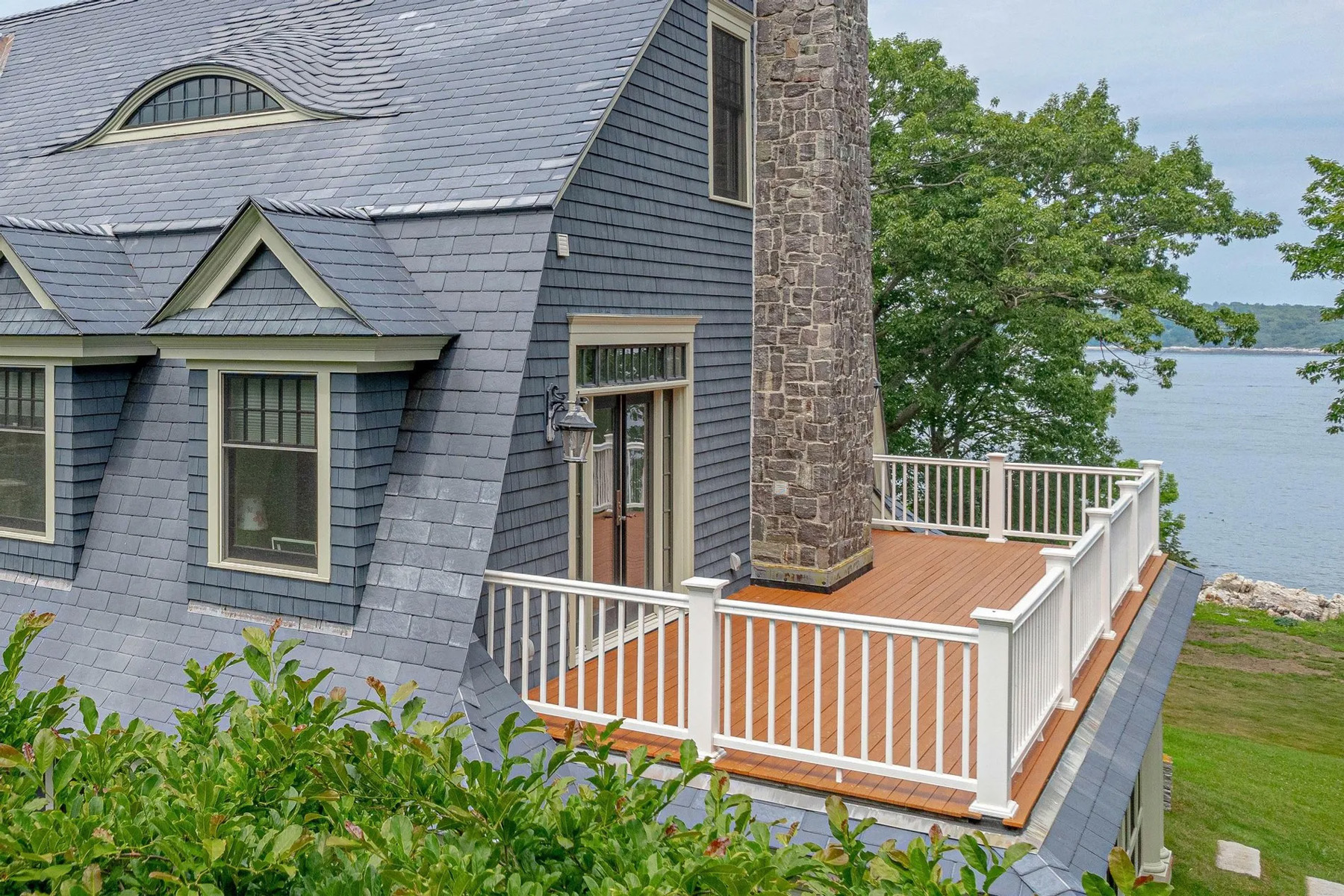Can You Paint Composite Decking?
Composite decking like Trex, Timbertech and Azek is a fantastic material. It’s weather resistant, maintenance free and very durable. However, it’s color typically fades over time from weather and sunlight. This can eventually make a deck appear grayish and dull. If this starts to happen you can paint composite decking. But there are a few important steps you need to take before you start. First, the deck needs to be thoroughly cleaned. Never paint a deck that’s dirty. If you do the paint can start to peel. Then, a primer should be used that’s designed for the composite material your deck is made of. Not all composite decking is the same. Finally, you can paint the deck with an outdoor deck paint.
It’s very important to identify what type of composite decking you have before you start painting. Because not all composites are the same. Some are primarily made from plastics while others contain polymers, wood pulp, glues, plastics, and fibers. You need to use a primer that’s designed for the type of material you’re priming. If you use a primer that’s not designed for the decking material you have, it can peel.
Do not skip the cleaning step. If the composite deck you paint contains oils or grease, or if it’s dirty, the paint can peel.
Once the deck is cleaned and primed, paint the decking with a brush, roller or sprayer. Usually just the top surface is painted and not the underside. But you can paint both sides of the decking if the underside of the deck is visible.
Painting New Vs Old Composite Decking
Early generation composite decking is easier to paint than new composite decking.
Newer types of composite decking can be protected by a PVC cap or shell. The outer shell encases and protects the decking inner core. The cap protects the decking which means lower maintenance, but it also prevents paint and stain from adhering. However, you can still paint brand new composite decking, even if it has a protective shell, as long as you use the right acrylic primer and paint.
New composite decking warranties can be made void if you paint them. For this reason, I only recommend painting composite decking when it’s old, faded, or out of warranty. But if you want to paint new decking, check with the manufacturer first.
Older composite decking is easier to paint. It doesn’t have a plastic cap or shell so paint sticks to it easier.
To determine whether your decking is capped or not, look at the cut end of a deck board. Early generation decking is the same color top to bottom. Newer composite decking will have a thin coating over the gray or brown composite core.
Older composite decking will accept paint much easier than newer designs. However, both can be painted if you do it correctly and use the right primer and paint.
Painting Wood Decking Vs Composite Decking
Painting wood decking and composite decking are almost exactly the same.
In both cases, the decking should be cleaned of any grease, oils, stains, dirt, grime, mold, mildew, pollen, etc. You should only paint a clean and dry surface.
Both wood and composite decking should be primed before you paint. A primer coat helps the paint adhere to the surface and prevents peeling. primers also fill in small gaps and pores which creates a smoother, more durable surface.
The primer and paint is applied in exactly the same way no matter if you’re painting wood or composite. use a sprayer, brush or roller to apply product. use smooth strokes and thin coats. Allow each coat to dry before applying the next.
The main difference is adhesion. The primers and paints you use on wood decking won’t work on composite decking because they won’t stick. The painting process and the tools are the same, but the materials you use are different.
To paint a composite deck, acrylic primers must be used first because they can stick to composite materials. Then when you paint the decking, the paint sticks to the primer and not the composite material.
If the composite decking has a protective cap or shell, you can scuff it with some medium grit sandpaper. This removes some of the thin protective shell layer which allows paint and primer to stick easier. However, this will most likely void the warranty so I wouldn’t recommend it unless the decking is already out of warranty, older, or you just don’t care about the warranty.
How To Paint Composite Decking
Painting composite Trex decking isn’t nay harder than painting wood. The only difference is the materials you need to use. Wood primer and paints are different than what you use on a composite material. This is why preparation and research is so important.
The first step you should take when painting a composite deck is research. Find out what type of decking you have an what it’s made of. Some composite decking, like Azek, are made primarily from plastics. For this type of decking you need a paint and primer that will work on plastics.
Other types of composite decking, like Trex, contain a bunch of different materials like fibers, glues, plastics, and wood pulp. They may require a different primer than what you use on plastic.
I always recommend testing the primer and paint on a small piece of decking first before painting the entire deck. This lets me see how the primer and paint will perform on my deck. If the primer or paint start to peel after a few days outside then you need something else.
Make sure the thoroughly clean the entire deck. Any oil, grease, dust or pollen left on the deck can make the primer or paint peel.
Once you’ve gathered all your materials and prepped the surface, it’s time to prime and paint the decking. You can use a roller, paint prayer or brushes to apply material.
Make sure to mask off areas you don’t want paint with plastic and tape.
In this section, we’ll review the entire composite deck painting process step by step and provide a list of all the tools you’ll need.
Tools
Painting a composite deck isn’t that hard, but you need the right tools and materials. If you want a professional looking job then you should always work with good tools.
Here’s a list of what you’ll need.
- Soft-Bristle Brush: For cleaning stuck on dirt off a deck’s surface.
- Pressure Washer: A great tool for cleaning a deck. Vary the pressure setting based on the condition and age of your deck.
- Cleansers: You can use a store bought cleanser or a homemade vinegar solution to remove mold and mildew.
- Commercial Composite Deck Cleaner: I like to use simple soap and water but if your deck is really dirty you may need something stronger.
- Bucket: I usually wash the deck with soap and water.
- Sponge or Brush: Wash the deck with a sponge or bristle brush on a pole.
- Plastic Sheeting: Use plastic sheets to mask off areas you don;t want paint.
- Sandpaper: I use a medium grit sandpaper to smooth out rough spots.
- Painter’s Tape: Used along with plastic sheeting to mask off areas.
- Primer: Make sure you use the correct primer for the composite material decking you have.
- Paint Sprayer, Roller, or Brush: For most composite decks I paint I end up using all 3.
- Paint: Use the correct paint for an outdoor composite deck.
Painting A Composite Deck Step By Step
Once you’ve figured out what type of composite decking you have, and all your materials are ready, it’s time to get started.
Here is a step by step guide on how to paint a composite deck.
Step 1: Clean The Deck
First, remove anything that’s sitting on the deck. Any plants, furniture, grills, etc. should be removed from the deck.
I always wear some rubber gloves when cleaning a deck. This is especially important if you’re using bleach or a chemical cleanser.
For most decks, I start off with some basic dish soap and warm water in a bucket. Scrub the deck with a brush on a long pole. Use a lot of soap. You want the deck to be full of suds and not just water.
I recommend using an anti bacterial soap. Many composite decks get some mold and mildew growth. Especially in dark areas or underneath plants and furniture.
If you’re using a commercial cleanser or a bleach solution, follow the instructions they provide. And make sure to wear the proper safety equipment.
If your deck has mold and mildew, you can use a store bought cleanser or a homemade solution. I generally start with a homemade cleaner and then use something stronger if it doesn’t work. A mixture of two parts vinegar and one part water usually does the trick. Let the solution soak in the moldy area for a few minutes before you clean it off.
Before I soak the deck in the cleaning solution, I usually apply some baking soda. Sprinkle the baking soda right onto the decking and scrub. Then apply the vinegar. This helps loosen up mold that’s worked its way into the decking.
Once you finish cleaning, I like to rinse the deck with a power washer. Use a low setting to avoid damaging the decking. make sure to rinse off all the soap, vinegar, bleach, cleansers, etc. You don;t want any residue left on the deck once you’re done.
After the deck is thoroughly rinsed, let it dry.
Step 2: Sand The Deck
There are a few reasons why you can sand a composite deck before painting it. But it’s an options step that you can sometimes skip.
Some types of composite decking, like plastics, aren’t easy to prime and paint. They’re so dense and smooth that paint doesn’t stick to them. However, if you scuff the surface a bit with a medium grit sandpaper, you make it easier for the paint to adhere.
Use medium-grit sandpaper and scuff up every surface you want to paint. All you generally need is a very light sanding. I have an orbital sander that can scuff up a deck in minutes. But if you’re using a small palm sander and have a big deck it could take a while.
Remember, you’re just scuffing the surface a little. Not sanding down the decking. Go light and fast over the surface. If you over-sand the deck in spots you can create an uneven surface. All you’re doing is de-glazing the very thin surface layer.
Always sand with the direction of the wood grain. If you sand against the grain it can leave marks.
After sanding, wipe away the dust with a damp rag.
The other reason you can sand a composite deck is to smooth down damaged gritty areas. In this case, use as much pressure as needed to smooth the area. Some types of composite decking can deteriorate and cause splinters just like a wood deck can.
Step 3: Preparation
Now that all the cleaning is done, it’s time to mask off areas you don’t want paint.
This is an important step if the deck is attached to the house you if you’re not painting the rails.
Use painters tape. I prefer Frog tape. It’s specially designed to resist bleeding and peeling. Cheap tape will usually bleed or peel once you remove the tape.
Use some plastic sheeting to cover the siding and deck rails you don;t want paint. Do the same for other things like planters, doors, trim or benches. Any surface you don’t want painted, cover with tape and plastic.
Step 4: Prime The Deck
One of the most important parts of painting a composite deck is priming it first. Most paints will not stick to composite materials. You have to prime the surface first to give the paint something it can stick to.
The primary purpose of a primer is to create a surface the paint can adhere to. Primer sticks to the composite decking and paint sticks to the primer.
Primer is thick and durable. It will fill in some of the deck’s small imperfections which creates a smoother surface.
Most composite decks work best with an acrylic latex primer designed for exterior use. It will stick to most composite surfaces without peeling as long as the surface is cleaned properly.
You can apply primer with either a brush, roller or sprayer. For most decks I use all 3. A sprayer is great if the deck isl ow and you don;t mind paint dripping through the gaps. However, if the area under your deck is finished you may want to use a roller. They give you more control over the paint.
I use a brush for small detail areas like around edges and corners.
I use a few different size brushes and rollers. Wide rollers are great for large open areas but small rollers are better for detail work. The same is true for brushes.
If you have some tight spaces to paint, try an angled brush.
One to two coats of primer is usually enough. The primer coat will help cover up the color of the decking. This is helpful if your switching from a dark deck to a lighter paint. It’ll also save you money because deck primer is usually cheaper than deck paint. An extra coat of primer can help eliminate an extra coat of the more expensive paint.
Step 5: Apply The Paint
After the primer has fully dried, you can start painting. It’s OK to walk on deck primer once it’s dried.
If you primed the deck properly, one to two thin coats is usually enough paint to cover.
Drying times will vary based on the paint you use. Let each coat thoroughly dry before you paint another coat. You can usually tell because wet paint is darker than dry paint.
Paint the entire deck in one coat and not in sections. This helps eliminate lines where you stopped painting and then started again. If you do stop, try to end at the edge of a deck board.
Always apply paint in thin coats. This creates a smoother, more consistent surface.
You can use a paint sprayer, roller or brush to paint a deck. On some deck I end up using all 3.
Paint sprayers are great fr larger areas however they don;t give you much control over what goes through the gaps between deck boards. For this reason I only use a sprayer on low decks where you don;t see the underside.
If the deck is high or you can see the underside of the decking, I use a roller for larger areas. They give me more control over the paint flow.
Brushes are best for detail areas and edges.
I usually use at least 2 sizes of rollers, a really wide roller for large open areas and a small roller for edges and detail work.The same is true for my brushes. I always bring a wide brush and a smaller angled brush for edges and detail work.
What Is Composite Decking?
Composite decking is man made and not made from wood. Although many types of composite decking contains wood fibers or pulp.
Most composite decking is made of plastics, wood pulp, glues, resins and wood fibers. They contain a binding agent that holed the materials together to form boards. Other types of composite decking, like Azek, is primarily made from plastic.
Because composite decking is not made from wood, it’s more durable and resistant to the elements.
Trex is a brand name of composite decking materials. They make several different types of composite decking. many people use the word Trex deck to describe a composite deck not realizing that trex is a brand. Other manufacturers of composite decking are Timbertech, Azek, Fiberon and Veranda.
Composite decking materials are fade, scratch, stain, mold, pest, and warp-resistant. However, some fading does usually occur.
Traditional deck paints and stains typically won’t stick to the plastic and resin components of the boards. Most paints quickly peel right off the surface. You need to use an acrylic-based primer and paint that can stick to composite decking.
Composite decking boards have either a solid or grooved edge. The grooved edge works with a hidden deck fastener clip. This eliminates the need to drill holes or drive screws into the deck when you install them.
Types Of Composite Decking
Not all composite deck boards are the same. Some are made by mixing together a variety of fibers, pulp, glues, resins, plastics, etc. the form a composite material that’s pressed into a deck board. others are made almost entirely of plastic.
No matter what type of composite decking you buy, they’re all man made and unnatural. Although some contain recycled materials which makes them greener than others.
Aside from the material used to make the decking, they come in a variety of designs. These include capped and uncapped, solid and hollow, as well as grooved and un-grooved. No matter which design you buy, the painting process is basically the same.
Composite decks are durable and resistant to mildew, mold, insects, and rot regardless of the type and board design.
Before you paint a composite deck, it’s important to know what type of material the decking is made from. The design of the boards don;t matter as much. Whether or not the boards have a grooved edge or a solid one doesn’t effect the paint.
The one thing that all composite decking has in common is that it requires special paint. Most exterior paints that are designed for wood or other materials will peel right off composite decking.
Should You Paint Composite Decking
Understand that the appeal of composite decking is that it needs no maintenance. Once you start painting the composite deck boards, you’ll create a maintenance cycle for the deck. No paint lasts forever. Eventually you’ll have to repaint the deck again and again. Usually this starts after 3-5 years from the initial paint job.A fading composite deck may look unattractive, but it still doesn’t need maintenance.
Because deck boards lie horizontally and face up, they’re exposed to the elements more than vertical surfaces. This means the sun and rain can beat down on them harder than your siding, fence or deck rails. Paint will fade and wear off much faster on a horizontal surface then it will a vertical one.
Applying two coats of paint on a primed composite deck will provide a thick, durable layer that will look like new. Paint is the best way to freshen up an old deck that doesn’t look great anymore.
Because composite decks are so popular and people like to paint them, many paint manufacturers make special lines of paint specifically designed for composite decks. Many of these paints can even be used without a primer. This makes painting the deck much faster and easier.
Paint and primer can also protect the deck from future damage. The top coating of a composite deck board not only looks good, but it also protects the inside of the board. If this top layer has completely warn off, the decking can start to deteriorate. A coat of paint can seal and protect the decking from damage.
The Best Composite Deck Paint
I always use a high-quality paint and primer whenever I paint a composite deck. Make sure to use a product that’s specifically designed for the type of composite decking you have.
Many paint manufacturers make paints and stains designed for composite decks. I’ve tried them and they work really well.
Decking manufacturers can help you find the right paint. If you know who made the deck boards and what type it is, contact the manufacturer for a recommendation.
Painting To Match Composite Trex Decking
Many types of composite decking like Trex have a glossy finish when brand new. If you want to match that sheen on your painted composite deck, use high-quality latex paint in a semi-gloss or satin finish. The color doesn’t matter because you can add a sheen to any color paint.
When you paint a composite deck, the color is completely opaque. However, when you look at most composite decking it has multiple colors. This gives the decking a more natural feel. Re-creating this look is very hard when you paint decking. However, it can be done if you take your time.
To recreate a wood grain, you have to paint on the grain with either a feather or a small spray gun. I use a gun designed for model painting. It’s tedious, time consuming artistic work. But the result is a more natural looking deck board.
Can I Change The Color Of A Composite Deck?
A composite deck’s color can be changed any time by painting it. Use an acrylic based primer and paint. make sure you use a paint and primer designed for the type of composite decking you have because they’re not all created the same.
Clean the deck thoroughly, then lightly scuff the surface with some medium grit sandpaper. Wipe the deck down to remove any dust created by sanding. Mask off areas you don’t want paint with painters tape and plastic sheeting. Apply 2 coats of primer and 1-2 thin coats of paint with either a sprayer, roller or brush.
I recommend using a paint with some UV protection built in. This will help resist color fading.
Other than using a paint or stain, there’s no way to change the color of composite decking.
Can You Paint Fiberon Decking?
Yes, I’ve painted Fiberon decking many times. Both new and old versions. Use a composite decking paint and primer made with acrylic latex. Many paint brands make paints and stains specifically for painting composite decking like Fiberon.
Painting Fiberon decking is the same as any other composite decking. Make sure the decking is totally clean and free of any dust, dirt, grime, grease, oil and pollen. Clean and dry the deck thoroughly. Then let it dry.
Once dry, scuff the surface of the decking with some medium grit sandpaper. This is an optional step. It helps the primer adhere to the decking but isn’t absolutely necessary. If you scuff the decking, wipe off any dust that’s created.
Mask off areas you don’t want painted with painters tape and plastic sheeting.
Apply 1-2 coats of primer with a roller, brush or sprayer.
Apply 1-2 thin coats of paint with a roller, brush or sprayer. Multiple thin coats are generally best.
Keep in mind that painting or sanding a newer Fiberon deck may void the warranty.
Can You Paint Timbertech Decking?
I’ve painted new and old Timbertech decking many times. Use a composite decking paint and primer made with acrylic latex. Many paint brands make paints and stains specifically for painting composite decking like Timbertech.
Painting Timbertech decking is the same as any other composite decking. Make sure the decking is totally clean and free of any dust, dirt, grime, grease, oil and pollen. Clean and dry the deck thoroughly. Then let it dry.
Once dry, scuff the surface of the decking with some medium grit sandpaper. This is an optional step. It helps the primer adhere to the decking but isn’t absolutely necessary. If you scuff the decking, wipe off any dust that’s created.
Mask off areas you don’t want painted with painters tape and plastic sheeting.
Apply 1-2 coats of primer with a roller, brush or sprayer.
Apply 1-2 thin coats of paint with a roller, brush or sprayer. Multiple thin coats are generally best.
Keep in mind that painting or sanding a newer Timbertech deck may void the warranty.
Tips For Painting Composite Decking
Here are a few tips to help you get the best results when painting a composite deck.
Paint When It’s Dry
Never do any exterior painting when there’s even a slight chance of rain. I also don’t like painting when it’s too damp or humid outside. Outside moisture will mix with the primer and paint which dilutes the material.
Make sure the deck boards you’re painting are totally dry.
Use A Thick Roller
I prefer using a thick roller when painting decking. Composite decking boards are not usually completely flat. They generally have some texture and grain too them which is easier to paint with a thicker roller. A thicker roller will also get some paint into the grooves between deck boards.
Don’t Paint In Direct Sunlight
Try not to paint at noon when the sun is at its hottest. The extra heat will dry out the paint and primer quicker which can create cracks.
Summary: Can You Paint Composite Decking?
Composite decking like Trex, Timbertech and Azek is a fantastic material. It’s weather resistant, maintenance free and very durable. However, it’s color typically fades over time from weather and sunlight. This can eventually make a deck appear grayish and dull. If this starts to happen you can paint composite decking. But there are a few important steps you need to take before you start. First, the deck needs to be thoroughly cleaned. Never paint a deck that’s dirty. If you do the paint can start to peel. Then, a primer should be used that’s designed for the composite material your deck is made of. Not all composite decking is the same. Finally, you can paint the deck with an outdoor deck paint.
It’s very important to identify what type of composite decking you have before you start painting. Because not all composites are the same. Some are primarily made from plastics while others contain polymers, wood pulp, glues, plastics, and fibers. You need to use a primer that’s designed for the type of material you’re priming. If you use a primer that’s not designed for the decking material you have, it can peel.
Do not skip the cleaning step. If the composite deck you paint contains oils or grease, or if it’s dirty, the paint can peel.
Once the deck is cleaned and primed, paint the decking with a brush, roller or sprayer. Usually just the top surface is painted and not the underside. But you can paint both sides of the decking if the underside of the deck is visible.
If you have any questions or comments about painting composite decks, email any time.























